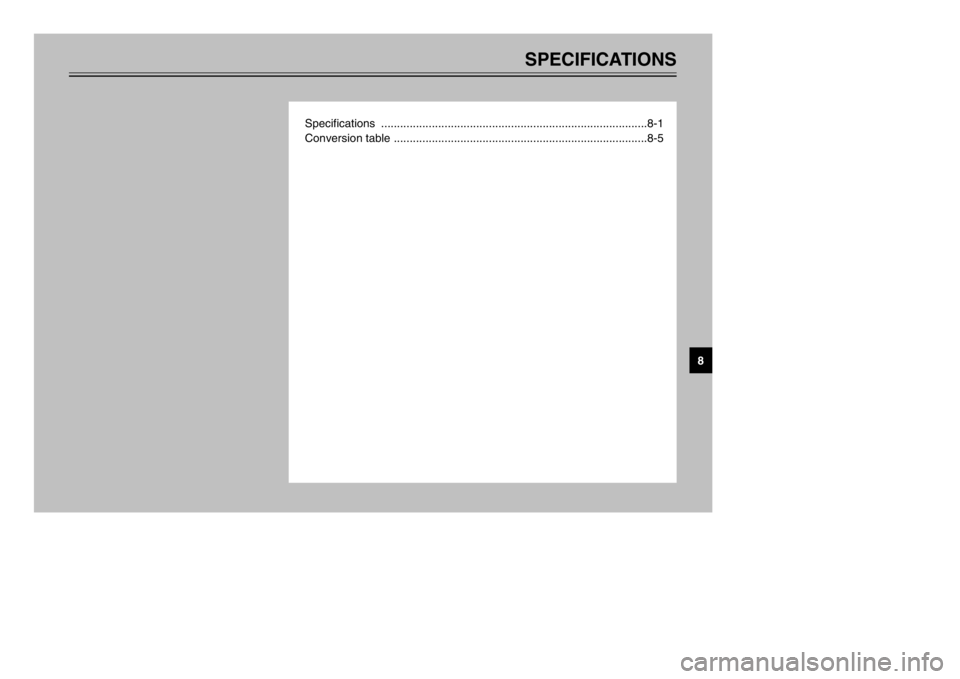Page 97 of 114

7-1
EAU03434
SCOOTER CARE AND STORAGE
7
CareCareWhile the open design of a scooter
reveals the attractiveness of the tech-
nology, it also makes it more vulnera-
ble. Rust and corrosion can develop
even if high-quality components are
used. A rusty exhaust pipe may go
unnoticed on a car, however, it
detracts from the overall appearance
of a scooter. Frequent and proper
care does not only comply with the
terms of the warranty, but it will also
keep your scooter looking good,
extend its life and optimize its perfor-
mance.Before cleaning
1. Cover the muffler outlet with a
plastic bag after the engine has
cooled down.
2. Make sure that all caps and cov-
ers as well as all electrical cou-
plers and connectors, including
the spark plug cap, are tightly
installed.
3. Remove extremely stubborn dirt,
like oil burnt onto the crankcase,
with a degreasing agent and a
brush, but never apply such
products onto seals, gaskets and
wheel axles. Always rinse the dirt
and degreaser off with water.Cleaning
ECA00011
cC8Avoid using strong acidic
wheel cleaners, especially on
spoked wheels. If such prod-
ucts are used on hard-to-
remove dirt, do not leave the
cleaner on the affected area
any longer than instructed.
Also, thoroughly rinse the area
off with water, immediately dry
it, and then apply a corrosion
protection spray.
8Improper cleaning can damage
windshields, cowlings, panels
and other plastic parts. Use
only a soft, clean cloth or
sponge with mild detergent
and water to clean plastic.
5SJ-28199-E0 1/24/02 6:14 PM Page 96
Page 98 of 114

7-2
SCOOTER CARE AND STORAGE
7 8Do not use any harsh chemical
products on plastic parts. Be
sure to avoid using cloths or
sponges which have been in
contact with strong or abra-
sive cleaning products, sol-
vent or thinner, fuel (gasoline),
rust removers or inhibitors,
brake fluid, antifreeze or elec-
trolyte.
8Do not use high-pressure
washers or steam-jet cleaners
since they cause water seep-
age and deterioration in the
following areas: seals (of
wheel and swingarm bearings,
fork and brakes), electric com-
ponents (couplers, connec-
tors, instruments, switches
and lights), breather hoses
and vents.8For scooters equipped with a
windshield: Do not use strong
cleaners or hard sponges as
they will cause dulling or
scratching. Some cleaning
compounds for plastic may
leave scratches on the wind-
shield. Test the product on a
small hidden part of the wind-
shield to make sure that it
does not leave any marks. If
the windshield is scratched,
use a quality plastic polishing
compound after washing.
After normal useRemove dirt with warm water, a mild
detergent, and a soft, clean sponge,
and then rinse thoroughly with clean
water. Use a toothbrush or bottle-
brush for hard-to-reach areas.
Stubborn dirt and insects will come
off more easily if the area is covered
with a wet cloth for a few minutes
before cleaning.After riding in the rain, near the sea
or on salt-sprayed roadsSince sea salt or salt sprayed on the
roads during winter are extremely
corrosive in combination with water,
carry out the following steps after
each ride in the rain, near the sea or
on salt-sprayed roads.NOTE:
Salt sprayed on roads in the winter
may remain well into spring.1. Clean the scooter with cold water
and a mild detergent after the
engine has cooled down.
ECA00012
cCDo not use warm water since it
increases the corrosive action of
the salt.2. Apply a corrosion protection
spray on all metal, including
chrome- and nickel-plated, sur-
faces to prevent corrosion.
5SJ-28199-E0 1/24/02 6:14 PM Page 97
Page 99 of 114

7-3
SCOOTER CARE AND STORAGE
7After cleaning
1. Dry the scooter with a chamois
or an absorbing cloth.
2. Use a chrome polish to shine
chrome, aluminum and stainless-
steel parts, including the exhaust
system. (Even the thermally
induced discoloring of stainless-
steel exhaust systems can be
removed through polishing.)
3. To prevent corrosion, it is recom-
mended to apply a corrosion pro-
tection spray on all metal, includ-
ing chrome- and nickel-plated,
surfaces.
4. Use spray oil as a universal
cleaner to remove any remaining
dirt.
5. Touch up minor paint damage
caused by stones, etc.6. Wax all painted surfaces.
7. Let the scooter dry completely
before storing or covering it.
EWA00002
w8Make sure that there is no oil
or wax on the brakes or tires.
If necessary, clean the brake
discs and brake linings with a
regular brake disc cleaner or
acetone, and wash the tires
with warm water and a mild
detergent.
8Before operating the scooter
test its braking performance
and cornering behavior.
ECA00013
cC8Apply spray oil and wax spar-
ingly and make sure to wipe
off any excess.
8Never apply oil or wax to any
rubber and plastic parts, but
treat them with a suitable care
product.
8Avoid using abrasive polish-
ing compounds as they will
wear away the paint.NOTE:
Consult a Yamaha dealer for advice
on what products to use.
5SJ-28199-E0 1/24/02 6:14 PM Page 98
Page 100 of 114

7-4
SCOOTER CARE AND STORAGE
7
StorageStorageShort-term
Always store your scooter in a cool,
dry place and, if necessary, protect it
against dust with a porous cover.
ECA00015
cC8Storing the scooter in a poorly
ventilated room or covering it
with a tarp, while it is still wet,
will allow water and humidity
to seep in and cause rust.
8To prevent corrosion, avoid
damp cellars, stables (because
of the presence of ammonia)
and areas where strong chemi-
cals are stored.
Long-term
Before storing your scooter for sever-
al months:
1. Follow all the instructions in the
“Care” section of this chapter.
2. Drain the carburetor float cham-
ber by loosening the drain bolt;
this will prevent fuel deposits
from building up. Pour the
drained fuel into the fuel tank.
3. Fill up the fuel tank and add fuel
stabilizer (if available) to prevent
the fuel tank from rusting and the
fuel from deteriorating.
4. Perform the following steps to
protect the cylinder, piston rings,
etc. from corrosion.a. Remove the spark plug cap
and spark plug.
b. Pour a teaspoonful of engine
oil into the spark plug bore.
c. Install the spark plug cap onto
the spark plug, and then place
the spark plug on the cylinder
head so that the electrodes
are grounded. (This will limit
sparking during the next step.)
d. Turn the engine over several
times with the starter. (This
will coat the cylinder wall with
oil.)
e. Remove the spark plug cap
from the spark plug, and then
install the spark plug and the
spark plug cap.
EWA00003
wTo prevent damage or injury from
sparking, make sure to ground the
spark plug electrodes while turn-
ing the engine over.
5SJ-28199-E0 1/24/02 6:14 PM Page 99
Page 101 of 114
7-5
SCOOTER CARE AND STORAGE
75. Lubricate all control cables and
the pivoting points of all levers
and pedals as well as of the
sidestand/centerstand.
6. Check and, if necessary, correct
the tire air pressure, and then lift
the scooter so that both of its
wheels are off the ground.
Alternatively, turn the wheels a
little every month in order to pre-
vent the tires from becoming
degraded in one spot.
7. Cover the muffler outlet with a
plastic bag to prevent moisture
from entering it.8. Remove the battery and fully
charge it. Store it in a cool, dry
place and charge it once a
month. Do not store the battery
in an excessively cold or warm
place [less than 0 °C or more
than 30 °C]. For more informa-
tion on storing the battery, see
page 6-35.
NOTE:
Make any necessary repairs before
storing the scooter.
5SJ-28199-E0 1/24/02 6:14 PM Page 100
Page 102 of 114
SPECIFICATIONS
Specifications ....................................................................................8-1
Conversion table ................................................................................8-5
8
5SJ-28199-E0 1/24/02 6:14 PM Page 101
Page 103 of 114

8-1
EAU01038
SPECIFICATIONS
8
SpecificationsSpecifications
Model YP250
Dimensions
Overall length 2,145 mm
Overall width 770 mm
Overall height 1,350 mm
Seat height 730 mm
Wheelbase 1,535 mm
Ground clearance 120 mm
Minimum turning radius 2,700 mm
Basic weight (with oil and full
fuel tank)170 kg
Engine
Engine type Liquid-cooled 4-stroke, SOHC
Cylinder arrangement Forward inclined single
cylinder
Displacement 249 cm
3
Bore ×Stroke 69.0 ×66.8 mm
Compression ratio 10:1
Starting system Electric starter
Lubrication system Wet sumpEngine oil
Type
Recommended engine oil
classification API Service SE, SF, SG type
or higher
cCBe sure to use motor oils that do not contain anti-friction
modifiers. Passenger car motor oils (often labeled “ENERGY
CONSERVING
II”) contain anti-friction additives which will
cause clutch and/or starter clutch slippage, resulting in
reduced component life and poor engine performance.
Quantity
Periodic oil change 1.2 L
Total amount (dry engine) 1.4 L
–10° 0° 10° 20° 30°
40°
SAE 10W/30
SAE 10W/40
SAE 20W/40
SAE 20W/50
–20°
SAE 15W/40 50°C
5SJ-28199-E0 1/24/02 6:14 PM Page 102
Page 104 of 114

8-2
SPECIFICATIONS
8
Final gear case oil
Type Engine oil SAE 10W-30
(API SE)
Total amount 0.25 L
Radiator capacity
(including all routes)1.4 L
Air filterWet type element
Fuel
Type REGULAR UNLEADED
GASOLINE ONLY
Fuel tank capacity 12 L
Carburetor
Manufacturer TEIKEI
Model × quantity Y28V-1E × 1
Spark plug
Manufacturer/model NGK/DR8EA
Spark plug gap 0.6–0.7 mm
Clutch typeDry, centrifugal automatic
Transmission
Primary reduction system Helical gear
Primary reduction ratio 40/15 (2.666)
Secondary reduction system Helical gear
Secondary reduction ratio 38/15 (2.533)Transmission type V-belt automatic
Operation Centrifugal automatic type
Chassis
Frame type Steel tube underbone
Caster angle 28°
Trail 103 mm
Tires
Front
Type Tubeless
Size 110/90-12 64L
Manufacturer/ IRC/MB67
model MICHELIN/BOPPER
Rear
Type Tubeless
Size 130/70-12 62L
Manufacturer/ IRC/MB67
model MICHELIN/BOPPER
Maximum load* 185 kg
Air pressure (cold tire)
up to 90 kg load*
Front175 kPa (1.75 kgf/cm
2, 1.75 bar)
Rear200 kPa (2.00 kgf/cm2, 2.00 bar)
5SJ-28199-E0 1/24/02 6:14 PM Page 103
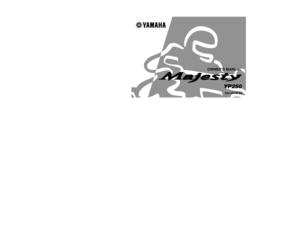 1
1 2
2 3
3 4
4 5
5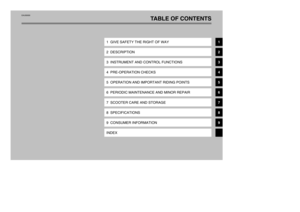 6
6 7
7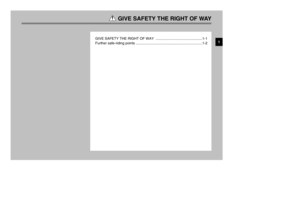 8
8 9
9 10
10 11
11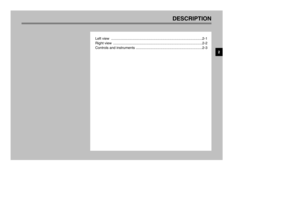 12
12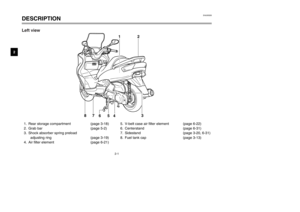 13
13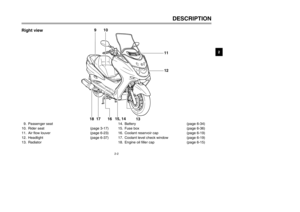 14
14 15
15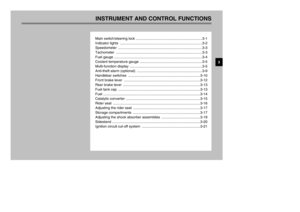 16
16 17
17 18
18 19
19 20
20 21
21 22
22 23
23 24
24 25
25 26
26 27
27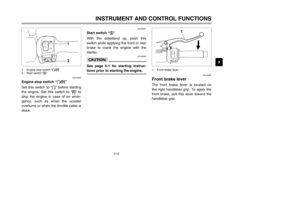 28
28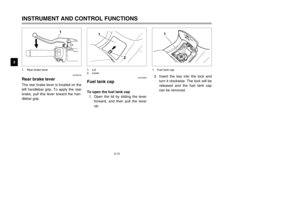 29
29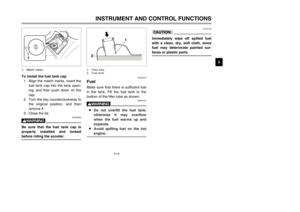 30
30 31
31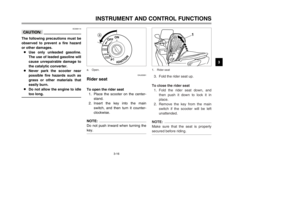 32
32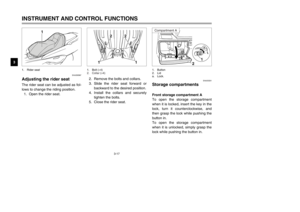 33
33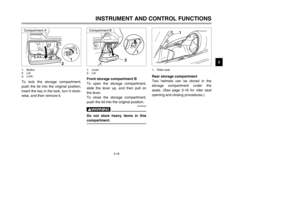 34
34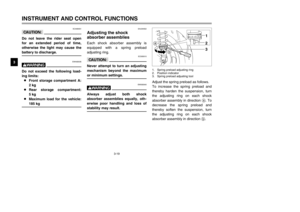 35
35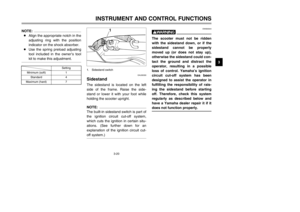 36
36 37
37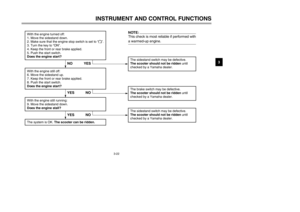 38
38 39
39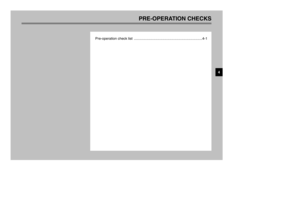 40
40 41
41 42
42 43
43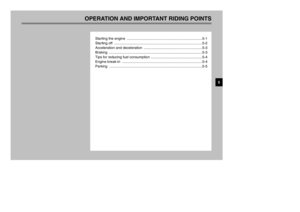 44
44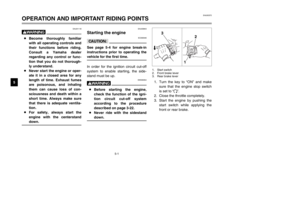 45
45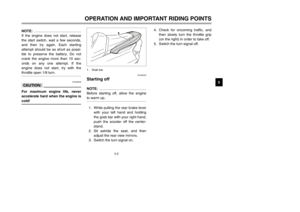 46
46 47
47 48
48 49
49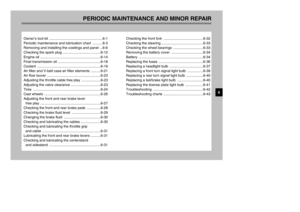 50
50 51
51 52
52 53
53 54
54 55
55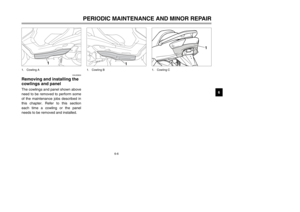 56
56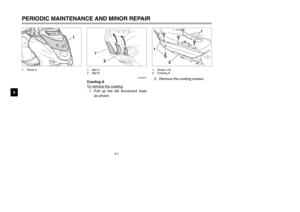 57
57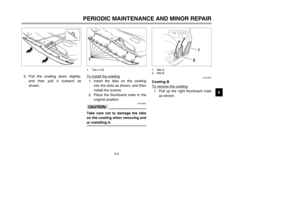 58
58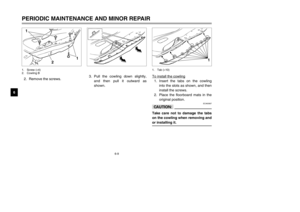 59
59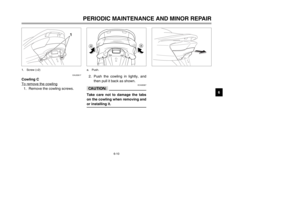 60
60 61
61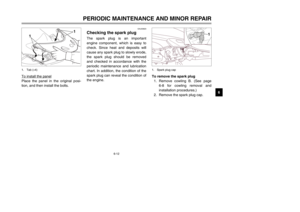 62
62 63
63 64
64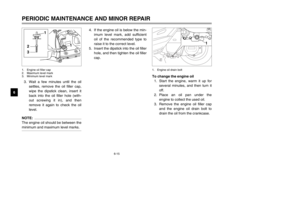 65
65 66
66 67
67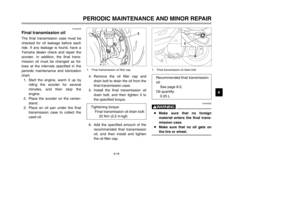 68
68 69
69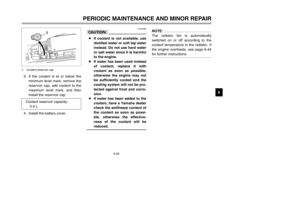 70
70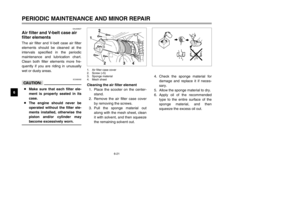 71
71 72
72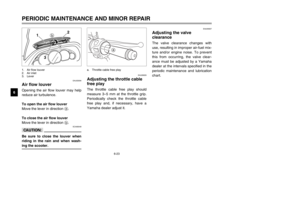 73
73 74
74 75
75 76
76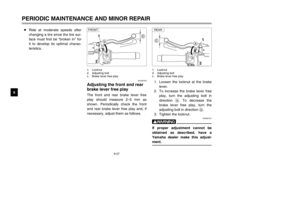 77
77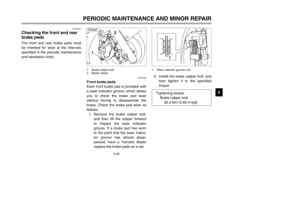 78
78 79
79 80
80 81
81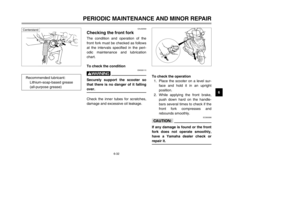 82
82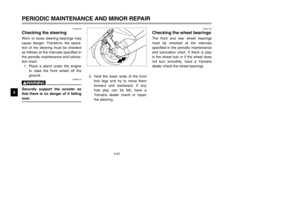 83
83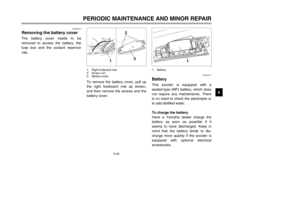 84
84 85
85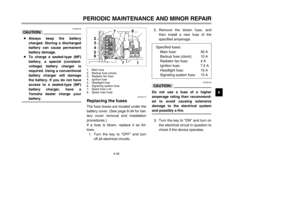 86
86 87
87 88
88 89
89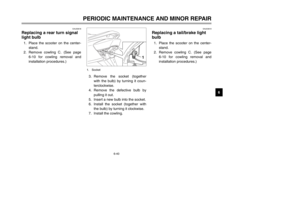 90
90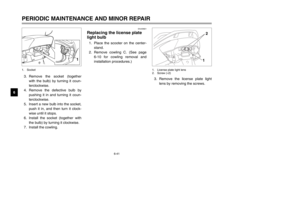 91
91 92
92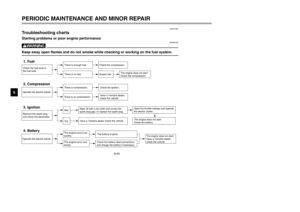 93
93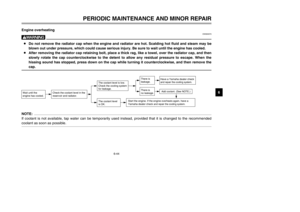 94
94 95
95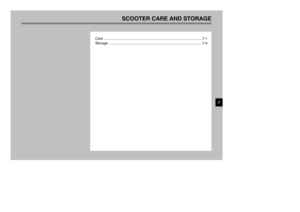 96
96 97
97 98
98 99
99 100
100 101
101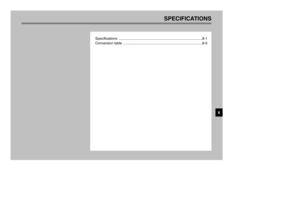 102
102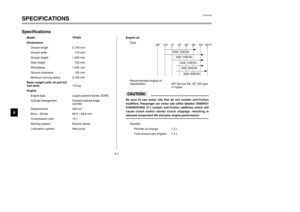 103
103 104
104 105
105 106
106 107
107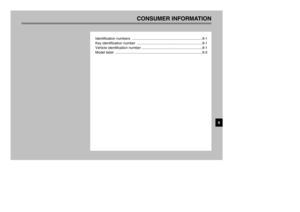 108
108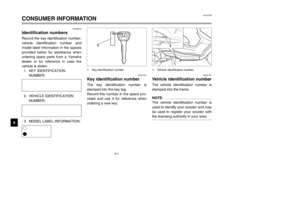 109
109 110
110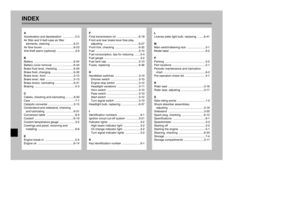 111
111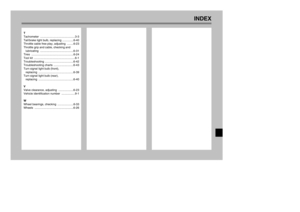 112
112 113
113




